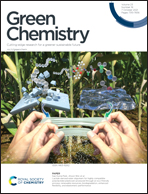Schiff-base molecules and COFs as metal-free catalysts or silver supports for carboxylation of alkynes with CO2†
Abstract
Carboxylation of terminal alkynes with CO2 to produce propiolic acids is an atom economical and high-value route for CO2 fixation and utilization, but the conversion under mild conditions needs transition metal catalysts. In this article, we demonstrated for the first time the transition-metal-free organocatalysts for the reaction. The efficient catalysts are Schiff bases derived from 1,3,5-triformylphloroglucinol (Tp), either homogeneous (discrete molecules) or heterogeneous (covalent organic frameworks, COFs). The key catalytic sites are phenoxo and imine groups, which activate CO2 through phenoxo–CO2 complexation and also activate the C(sp)–H bond through bifurcate C–H⋯Nimine and C–H⋯Ophenoxo hydrogen bonds. The 2,2′-bipyridyl sites in the COF also contribute to the catalytic performance. The COF catalyst is less active than the molecular one but has the advantages of heterogeneous catalysis. Higher performance was also demonstrated by combining silver nanoparticles (AgNPs) with the intrinsically catalytic COF. This work opens up the potential of developing transition-metal-free catalysts for the CO2 conversion reaction and demonstrates the new prospects of COFs as tailorable platforms for heterogeneous catalysis.



 Please wait while we load your content...
Please wait while we load your content...